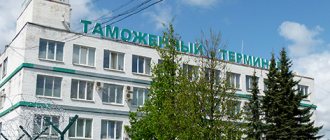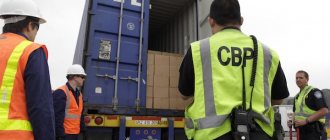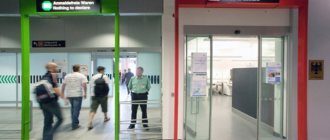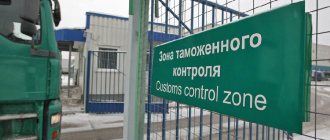Customs terms and abbreviations
Carnet TIR, TIR Book Book of control over the delivery of goods according to the rules of international transport.
Internal Customs Transit Delivery under customs control in the territory of the Customs Union.
Customs Control Zone Custom examinstion zone Customs control zone - in the Russian Federation - a checkpoint across the state border and the adjacent territory where customs control is carried out by customs officials, as well as the territories and premises of enterprises and organizations storing goods and other items under customs control control.
“from the wheels” Release of goods into free circulation without being placed in a temporary storage warehouse or in a Customs Warehouse in the presence of all the documents necessary for customs clearance.
Temporary storage warehouse (TSW) A temporary storage warehouse is a permanent customs control zone for placing goods under customs procedures (import, export, transit, etc.) At a temporary storage warehouse, goods can be forcibly unloaded if all the documents necessary for customs clearance are not provided or goods subject to mandatory unloading at a temporary storage warehouse. Goods can be stored at a temporary storage warehouse for no more than 2 months, then they must be placed under any customs procedure, for example, released for free circulation or declared under the customs warehouse regime. At a temporary storage warehouse, goods may undergo operations necessary to ensure their safety in an unchanged condition, including the correction of damaged packaging. You can inspect and measure the goods; with the permission of the customs authority of the Russian Federation, samples and samples of goods can be taken.
Customs ; Customs House Customs is a state body that ensures the procedure for moving goods and vehicles, things and other items across the customs border, the application of customs regimes and the collection of customs payments, carrying out customs control and customs clearance.
Customs clearance Customs clearance - completion of the necessary formalities arising in connection with the movement of goods and vehicles across the customs border. Customs clearance includes: — customs clearance; — payment of customs duties. Customs clearance is a necessary condition for crossing the customs border.
Customs warehouse The following operations can be carried out with goods placed under the customs regime: to ensure the safety of these goods; to prepare goods with the permission of the customs authorities of the Russian Federation for sale and transportation - splitting batches, forming shipments, sorting, packaging, repackaging, labeling, loading, unloading , overload and other similar operations.
Customs control Customs examination; Customs check Customs control: — verification of documents, markings and security; — inspection and accounting of vehicles, goods, currency, valuables; + other actions of customs officials regulated by the legislation of the country, aimed at ensuring compliance by legal entities and individuals with the procedure for moving goods and other items across the customs border.
Participant in foreign economic activity (participant in foreign economic activity) An individual or legal entity carrying out foreign economic activity on the basis of the legislation of the Russian Federation.
AS KDT - automated system for monitoring the delivery of goods;
ASMAP - Association of International Road Carriers;
BNA FOISP - Bulletin of regulatory acts of federal executive authorities;
VGTD - temporary cargo customs declaration;
VTT - internal customs transit;
FEA - foreign economic activity;
VEC of Russia - Federal Service of the Russian Federation for Currency and Export Control;
Anatomy of one PTC
From time to time, reviews of various smartphones, tablets, laptops and other small gadgets appear on Habré. This article offers you an overview of a larger unit, namely the software and hardware complex (SHC) that controls a machine the size of a multi-story building. To explain the scale of the device, the photograph shows one of its parts - a heating steam turbine, which in the future will drive an equally impressive electric generator. The most remarkable thing is that with the help of steam from a huge boiler, it is necessary to control this turbine so that it produces 3000 rpm with an error of no more than ±0.1% at any operating load of the generator.
Introduction
We all use electricity, hot water and heating every day. But we think much less often about how and where all these benefits come from into our home or office. Meanwhile, there is something to look at and talk about: after all, power plants are one of the largest and most complex mechanisms, the control of which is a very non-trivial task. Thermal power plants come in different types: thermal power plants, state district power plants, gas thermal power plants and many others, but the essence of their work does not change: the input is minerals, the output is heat and electricity.
This is what a small supply of coal looks like for a coal-fired power plant. The bulldozer stirs it from time to time so that it does not burn and smoke too much.
It is worth noting that there are no two absolutely identical power plants, even if they are of the same type and made according to the same design. As a result, the control system of any power plant is unique and made in a single copy.
One of two dozen Moscow power plants is CHPP 21. Cooling towers are visible, from which steam is pouring out.
To simplify greatly, the vast majority of devices for producing heat and electricity consists of:
- Heating element; its role can be played by a gas/fuel oil/coal/nuclear furnace (in the latter case, however, it is usually called a reactor).
- A boiler in which the working fluid is heated; here the market leader is water; in rarer cases, there may be no boiler with water (GTPP), then a stream of hot gas directly affects the turbine.
- Electric generator drive; This is one or another type of turbine.
- Actually, the electric generator itself; These devices can be very different, from small to colossal (their main indicator is the power of the generated current; in fact, the greater the power, the larger the size).
- A huge and complex electrical system.
There are also a number of other equally important and complex devices, such as cooling towers, network heaters, chemical water treatment laboratories, etc.
— you can’t tell everything in one article. The furnace, boiler, turbine and generator form a single unit, which is called a power unit. As a rule, one power plant has several power units, not necessarily of the same capacity.
One of the parts of the power unit is the turbine. The firebox, together with the boiler from which the steam lines come, are located in another room.
The task of an automated control system (ACS) includes both the control of one station power unit (unit ACS) and their combination (station ACS).
Control room of power unit No. 6 of the Ryazan State District Power Plant. The power unit capacity is 800 MW, the control system is PTK Kvint.
So how does a PTC turn into an automated process control system? As already noted, there are no two identical power units and, especially, power plants. Therefore, in order to automate something using a universal hardware and software system, it is necessary to first determine its hardware configuration and then write technological programs for controlling the automation object. Programmable logic controllers (PLCs) collect information from sensors, process it, and issue control actions to actuators. At the same time, controllers are responsible for protecting equipment and personnel in case of emergency situations, interacting with operators, providing all operational data for subsequent archiving, and much more. The controller has been doing this work around the clock for many years. Thus, although the controller is only one of many components of the PTC, it is perfect for the first review.
We disassemble the PLC
Just as a good theater starts with a coat rack, a good controller starts with a control cabinet.
Laboratory equipment cabinet with door removed. Designed for testing software and hardware - hence the slight operational mess.
On the top floor there are redundant power circuits - ~220 / = 24 V converters. They emit a significant part of the heat and therefore are located as close as possible to the cabinet ventilation hatch. Below are voltage stabilizers and fuses. The next row contains two processor modules of the controller, connected according to a hardware duplication scheme. One of the processor modules is in an active state, and the other is in a passive state. The active module controls the technological process, and the passive one constantly monitors the actions of the active one and monitors its health, always ready to take over control in a couple of milliseconds. Between the modules there is a simple hardware selection block (the green block in the middle); it serves as an arbiter between them. Based on the state of the outputs of this block, the modules decide whether to take over control or give it to a neighbor, and the time for making such a decision does not exceed 1 ms. Even lower, there is a duplicate USO station. It consists of two hardware modules (in the photo these are the two outermost modules on the left), each of which works with its own controller module. Because Control influences on the object are exerted only by the active controller module, then tasks for the USO are issued only by the module of the duplicated station that is connected to the active controller. The depicted USO station included 15 different USO modules necessary for testing. On the cabinet walls there are two rows of vertical cable channels, between which additional elements can be installed - terminal connections, discrete switches, etc.
External view of the controller processor module with the decorative cover removed.
The controller can be configured using buttons and a small OLED screen with 64 familiar spaces (4 lines). In real conditions, these elements have to be used once - during the initial configuration of the module, for example, to give it a static IP address and execution type (single/duplicate). Once the module is available over the network, the remaining settings can be performed remotely using the appropriate CAD software (of course, if you have the necessary rights). Things are completely different at the test site - this part of the controller is most in demand, because Almost every day we have to change its configuration or block the secure access system for new tests. On the left side of the case there are connector sockets for connecting a hardware clock pulse (usually it is not used, since the time is quite accurately synchronized from the NTP server), duplicated 24 V power supply and signals from the selection unit. On the right are three 100 Mbps Ethernet network ports. Two of them are for connecting a duplicated block network, one is for a data exchange cable between two processor modules of a duplicated controller (point-to-point connection).
Processor module, bottom view.
At the bottom there are three ports for connecting up to 3 different OSO buses. Physically, these are RS-485 ports, respectively, the length of each bus is determined by its operating frequency and can range from 5 to 1400 m. Each bus can communicate with the device either via the in-house R-400 protocol or via the Profibus-DP protocol. In accordance with this, either branded USO stations or Profibus USO stations are hung on the bus. If the bus operates using the Profibus-DP protocol, digital local control devices, such as smart valves, motors and other fittings, can be directly connected to it.
Let's start disassembling. First you need to free yourself from the body. To do this, just remove the back cover; It's secured with six plastic clips, so it's relatively easy to do.
Processor module with the back cover removed. The stabilization board with strong 2200 uF capacitors immediately stands out.
Now you can free yourself from the front cover. Since there was no decorative sticker on the front side of the case initially, access to all the necessary fasteners is free; all that remains is to unscrew 8 screws.
Under the front cover there is an MBC board, to which an OLED display is soldered with its own controller and proprietary firmware, with support for the Russian font.
The entire stack of boards connected via the PC/104+ bus is visible.
The layout of the controller module is made according to the PC/104+ standard. De facto, this arrangement has become standard in the industrial automation industry. Accordingly, all base boards of the module operate in this stack, which makes it relatively easy to expand the controller layout. All boards are attached to each other on brass stands. The stands for attaching to the front cover are plastic. There are relatively few additional communications between the boards - these are power wires and port cables. Let's go further and disconnect the boards, freeing them from the cables.
All boards in one plan.
The copy chosen for review has a minimal configuration and is equipped with one adapter for the proprietary USO bus, so there are not very many boards in the stack (from left to right, top to bottom):
- power stabilizer - STB-4100,
- assembly of 3 Ethernet ports - PPE-4102,
- power supply board, ports for connecting peripherals and local controls - MBK-4100,
- TME-104P-CSR-LX800 processor board with one Ethernet port,
- internal bus adapter USO – MIS-4100,
- duplicate Ethernet adapter.
Internal power stabilizer of the STB-4100 controller module.
STB-4100. View from the side of the power connectors of the processor board and the MBK-4100 board
It's a simple board, but it performs very important functions. Firstly, it stabilizes and filters the 5 V output voltage for the processor, and distributes ± 24 V input voltage to the MBK-4100 board. Secondly, it can ensure short-term operation of the entire module in the event of a loss of external power. This will allow the controller module to work for sufficient time so that it can save all operational data into non-volatile memory and be able to complete its work adequately, with a high probability of restoring its state after the breakdown is eliminated.
MIS-4100 proprietary fieldbus adapter. View from the side of the PC/104+ support processor
MIS-4100. View from the side of the R400 proprietary fieldbus support processor
Following the stabilizer in the stack there is a proprietary field bus adapter USO MIS-4100. On a double-sided board, there is a microprocessor on each side. The Altera Cyclone processor is responsible for supporting the PC/104+ bus, and Atmel is programmed as a master on the proprietary USO bus - R400. The bus itself is essentially I²C, overclocked to a frequency of 10 Mbit/s and implemented on the “physics” of RS-485. The bus is duplicated by simply doubling the communication lines. This is a well-tested and proven hardware solution that has been working on sites for more than one year. Through this bus, the controller module communicates with proprietary USO stations, to which, in turn, USO modules are connected. Exchange between stations and USO is carried out using the Modbus protocol. This two-level arrangement makes it possible to locate the control unit modules in close proximity to the facility in separate hardware cabinets. In this case, the distance between the controller and individual USO stations can exceed a kilometer.
Processor module Cool SpaceRunner-LX800
The processor, in modern times, has more than modest characteristics: CPU
- 64 KB L1 cache
- 128 KB L2 cache
- 256 MB DDR SDRAM 400 MHz
Chipset
- 1 x 32-bit PC/104-Plus
Expansion slots
- 1 x 16-bit PC/104 DMA compatible
Interfaces
- Ethernet 10/100BaseT
- ATA-6 EIDE (Ultra DMA-100)
- PS/2
- 4 x USB 2.0
- 2 x RS232/RS485/RS422
- 1 x LPT
- SVGA
- SSD to EIDE
The actual performance of the CPU, together with memory, is somewhere at the level of the first Pentiums of the late 90s of the last century.
This poor performance is primarily due to the fact that it must remain cold even under prolonged maximum loads. In the conditions prevailing at thermal power plants, this quality is of the greatest value - the dissipated power is stated to be within 3 - 4 Watts. Processor operating temperatures range from -40°C to +85°C, with a mean time between failures of almost 300,000 hours. Of all the interfaces located on the processor board, only the Ethernet adapter is used. Through it, communication between the modules of the duplicated controller is carried out. This connection serves for quick synchronization of accumulated data. In this case, the data in the passive module lags behind the data in the active module by no more than a few milliseconds. This allows for automatic shock-free (in the technological sense) switching of activity in the event of a problem in one of the modules.
Advantech Duplicate Ethernet Adapter Card
To communicate with upper-level stations, each controller module is equipped with a duplicate Ethernet adapter. This was done for the same reasons for which the USO bus is duplicated: all data buses that go far into the “field” must be duplicated, because the probability of damage to a communication line is directly proportional to its length. If the controller is duplicated, then a pair of network “cords” will be connected to each of its modules. Thus, the duplicated controller works with the network via four independent communication lines. Each network adapter located on the board supports Gigabit Ethernet. However, in practice, such capacity is redundant, because The controller's central processor has relatively low performance.
Basic switching module – MBK-4100
This module has many different tasks:
- aggregation of all interface ports of the controller,
- support for local control user interface (screen, buttons),
- control of input voltage and generation of emergency interrupts,
- support for hardware selection module for a duplicate controller,
- securing the stack of controller module boards to the housing.
One of the types of proprietary USO modules is ADC-4122.
Strictly speaking, USO modules no longer belong to the controller, but are its periphery. But, nevertheless, it is interesting to look at one of these modules. In this case, this is an analog-to-digital converter module with customizable potential inputs with individual galvanic isolation. Used to take readings from thermocouples TXA and TXK. The specific type of thermocouple that will be connected to one of the module’s eight channels is indicated when compiling the controller’s technological program and sent by the controller to the USO module in the form of settings.
Instead of a conclusion
Controllers and control units are just one part of the hardware and software package, but it is with them that the development of a new project for power plant automation begins. At first, the volume and types of signals that need to be received from the object’s sensors and generated for the actuators are determined. After this, it is already possible to calculate the number of required controllers and the composition of the control unit in each of them. Once everything is known, a testing ground is created where the required hardware configuration can be implemented.
Hardware racks at the test site are designed for mounting and testing the designed hardware configuration of the future automated process control system.
These USO modules have yet to be assembled into the station and placed on racks.
Future server automated process control system.
Installation of a cross-panel for one of the cabinets with network equipment.
Operator stations. They will also be deployed at the training ground. This is required by round-the-clock tests of the uninterrupted operation of the future control complex.
Once the hardware configuration of the PTC becomes known, you can begin writing technological programs for the controllers. To do this, the type and hardware composition of the controller is described using CAD.
In CAD for PLC programming, the hardware composition of the device is described.
Now, having a virtual image of all equipment, you can write technological programs to control the technical process. The dialects of programming languages from the IEC 61131-3 standard are used as languages for such programs.
Two software modules in FBD (left) and ST (right) languages. View from CAD PTK Kvint.
In addition to programming the operating logic of the controllers, it is also necessary to program the operator interface. This is no less complex and responsible task than programming controllers. The graphical interface must be easily understandable to the operator at first glance; it is subject to strict ergonomic requirements, because With this interface, operators will have to work in 12-hour shifts for a long time.
When technological programs and operator interfaces are ready, they are deployed at the test site on real equipment, where they undergo preliminary tests. When the main errors have been eliminated, the configured and programmed equipment is disassembled, packaged and sent to the site, where it will work for many years without interruptions or stops.
After what is written.
The article has been collecting dust in drafts for more than 6 years. Since then, a lot of water has flowed under the bridge and a lot of coal has been burned. Much has changed, some have disappeared (for example, the Quint PTK), but the essence of the process itself has remained the same.
TYPES OF DOCUMENTS
- Civil Code of the Russian Federation - Civil Code of the Russian Federation
- Law - federal law of the Russian Federation
- Code of Administrative Offenses of the Russian Federation - Code of the Russian Federation on Administrative Offenses
- Tax Code of the Russian Federation - Tax Code of the Russian Federation
- Letter - letter from the Federal Customs Service (State Customs Committee of the Russian Federation)
- Decree - resolution of the Government of the Russian Federation
- Order - order of the Federal Customs Service (State Customs Committee of the Russian Federation)
- Order - order of the Federal Customs Service (State Customs Committee of the Russian Federation)
- Teletypewriter - teletypewriter FCS (State Customs Committee of the Russian Federation)
- Telephone message - telephone message of the Federal Customs Service (State Customs Committee of the Russian Federation)
- Decree - decree of the President of the Russian Federation
- Instruction—instruction of the Federal Customs Service (State Customs Committee of the Russian Federation)
INSTITUTIONS, ORGANIZATIONS
- VAS - Supreme Arbitration Court
- SC - Supreme Court
- SCRF - State Commission on Radio Frequencies
- State Tax Service - State Tax Service
- KVTS - Committee on Military-Technical Cooperation with Foreign States
- MPS - Ministry of Railways
- MEDT - Ministry of Economic Development and Trade
- MED – Ministry of Economic Development
- OLAF - European Anti-Fraud Office
- OTS and A – Department of Customs Statistics and Analysis
- OFTD and UDS - Department of Federal Customs Revenues and Customs Cash Accounting
- PKKN - Standing Committee on Narcotics Control
- FSKN - Federal Service for Drug Control
- EKS - Expert Forensic Service
- FAPRID - Federal Agency for Legal Protection of the Results of Intellectual Activity of Military, Special and Dual Purpose under the Ministry of Justice of the Russian Federation
- FAS - Federal Antimonopoly Service
- FGUZ - Federal State Healthcare Institution
- FSVTS - Federal Service for Military-Technical Cooperation
- FSVFN - Federal Service for Veterinary and Phytosanitary Surveillance (Rosselkhoznadzor)
- FSSP - Federal Bailiff Service
- FSTEC - Federal Service for Technical and Export Control
CUSTOMS
- FCS (State Customs Committee of the Russian Federation) - Federal Customs Service (formerly State Customs Committee of the Russian Federation) CTU (MTU) - Central Customs Administration (formerly MTU) MTU - Moscow Customs Administration MZT - Moscow Western Customs MVT - Moscow Eastern Customs MYuT - Moscow Southern Customs MST - Moscow northern customs
- DVTU - Far Eastern Customs Administration
- MAGT - Moscow Truck Customs
- MZDT - Moscow Railway Customs
- Vocational school - Privolzhskoe customs department
- NWTU - North-Western Customs Administration
- NWAT - North-Western Excise Customs
- NWOT - North-Western Operational Customs
- SPT - St. Petersburg Customs
- STU - Siberian Customs Administration
- UTU - Ural Customs Administration
- YuTU - Southern Customs Administration
- GNIVC - Main scientific and information computing center of the federal customs service
- GUOTK - Main Directorate for Organization of Customs Control
- GUBK - Main Directorate for Combating Smuggling
- GUTNR - Main Directorate of Tariff and Non-Tariff Regulation
- GUTNiTO - Main Directorate of Commodity Nomenclature and Trade Restrictions
- GUFTD - Main Directorate of Federal Customs Revenues
- SOTC - Service for Organization of Customs Control
- UVK - Currency Control Department
SEBEPO-WESTERN EXCISE CUSTOMS POST (specialized)
Code 10009190 November 25, 2011 Actual address: 194292, St. Petersburg, Kultury Ave., 40A Fax 640-13-63, 173-229 Intercity exit code 8 - 812
| MANAGEMENT | ||
| Head of the post, colonel of the customs service | Osinov Alexander Valerievich | 337-57-38 |
| Deputy post commander | Sivak Roman Antonovich | 337-22-25 |
| Reception | Tarasova Ekaterina Sergeevna | 337-57-38 640-13-50f |
| Head of Accounting and Financial Expertise Department | Yakshina Lyubov Mikhailovna | 640 02-57 640-0264 |
| Head of Legal Department | Gandyzhalieva Marina Borisovna | 640 13 52 |
| Head of the customs transit control department | Boykov Mikhail Evgenievich | 640-57-31 |
| Head of the Department of Commodity Nomenclature and Trade Restrictions | Titova Olga Nikolaevna | 6 405 730 |
| Head of Customs Payments Department | Galkina Irina Vladimirovna | 640-02-50 |
| Head of Customs Value Control Department | Siling Olga Nikolaevna | 640-13-59 |
| Head of Customs Statistics Department | Drozhzhina Yulia Vladimirovna | 337-22-55 |
| Head of the department of work with excise stamps | Semenyuk Nina Sergeevna | 640-02-72 |
| Stamp Warehouse | Korotkevich Svetlana Nikolaevna | 640-22-71 |
| GGTI on customs regimes | Averkin Andrey Andreevich | 318-57-86 |
| Head of OPSUR | Zhdanova Anastasia Yurievna | 640-22-84 |
| DUTY OFFICER | 640-02-27 | |
| Head of general maintenance and technical department (special cargo) | Kovtun Nikolai Ivanovich | 640-13-54 |
| OTO and TC No. 3 | ||
| Code: 10009193 Actual address: 194292, St. Petersburg, Kultury Ave., 40A Intercity exit code 8 - 812 | ||
| Deputy Head of the Customs Post - Head of General Customs Department and Customs Committee No. 3 | Kryukov Vladimir Valentinovich | 449-40-85 |
| Deputy Head of Department | Teterin Kirill Vitalievich | 449 40-85 |
| Head of Customs Inspection Department | Novozhilov Denis Nikolaevich | 449-40-85 |
| OTO and TC No. 4 | ||
| Code: 10009194 Actual address: 1982068. St. Petersburg, Petergofskoe highway, 67 Intercity exit code 8 - 812 | ||
| Deputy head of the customs post - head of the General Customs Department and Customs Committee No. 4 | Martinovich Natalya Mikhailovna | 718 32-78 |
| Deputy Head of Department | Egorov Nikita Vyacheslavovich | 6 470 244 |
| OTO and TC No. 5 | ||
| Code: 10009195 | ||
| Head of General Maintenance and Technical Committee No. 5 | Semenov Vitaly Ivanovich | 8(813 78) 60 081 |
| OTO and TK special. cargo | ||
| Head of general maintenance and technical department special. cargo | Kovtun Nikolai Ivanovi | 6 401 354 |
| OTO and TC No. 6 (code 10009196) | ||
| Head of General Maintenance and Technical Committee No. 6 | Kamensky Segei Pavlovich | 8 (813 75) 191 132 |
| OTO and TC No. 7 (code 10009197) | ||
| Head of General Maintenance and Technical Committee No. 7 | Teterev Oleg Ivanovich | 7 022 902 7 022 897 |








